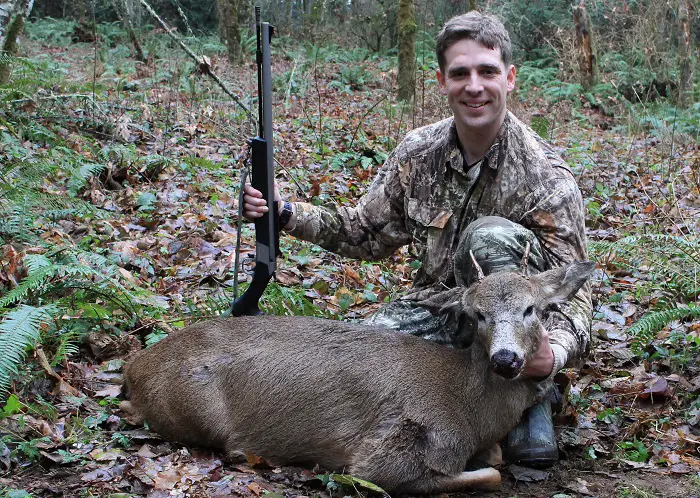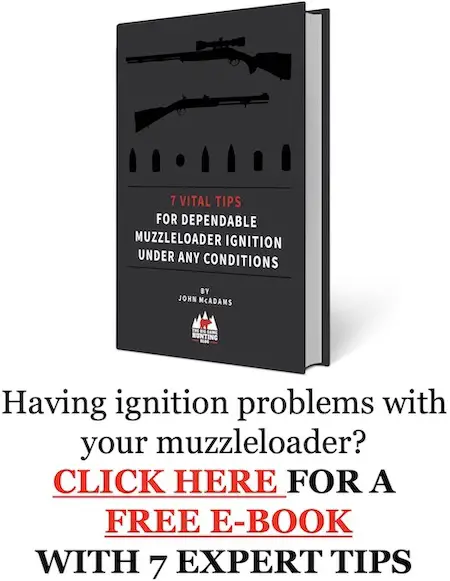Check out this article about cold weather muzzleloader hunting tips.
Hunting big game with a muzzleloader can be an extremely fulfilling experience and as a result, muzzleloader hunting is becoming more and more popular among hunters these days. However, hunting with a muzzleloader (regardless of whether it’s a traditional muzzleloader of a top of the line modern muzzleloader) can also be extremely challenging and frustrating. This is especially true with late season muzzleloader hunting where hunters may have to deal with extremely cold and/or wet conditions. For those who are planning on taking the old front stuffer out into the woods this year, here are a few cold weather muzzleloader hunting tips that I’ve learned the hard way.
Properly Seat Bullet
For both safety and performance reasons, it is extremely important to fully seat the bullet (or ball) snugly against the powder when loading your muzzleloader. If there is an air gap between the powder and the projectile, it will act as an obstruction in the barrel, potentially damaging the muzzleloader and causing injury to the shooter. Proper and consistent seating of the bullet is also essential to good accuracy when shooting your muzzleloader.
Carry Muzzleloader Barrel Up
Depending on the muzzleloader and bullet you are using, some bullets may slide down the barrel when the muzzleloader is carried with the muzzle pointing down (I’ve personally had this issue with PowerBelts). As pointed out above, this is both unsafe, and bad for accuracy. To avoid this issue, carry your muzzleloader with the barrel pointing up whenever possible. It is also a good idea to check it periodically with your ramrod to ensure that your bullet is still fully seated.
Cover Muzzle
Since you will be carrying the muzzleloader with the muzzle pointing up, and since muzzleloaders typically have large diameter bores, they are particularly vulnerable to things like snow, water, leaves, and other pieces of debris entering the muzzle without your knowledge. Not only can this create a potentially dangerous barrel obstruction, but it is also bad for accuracy. To avoid this, cover your muzzle with something like a piece of shipping tape or a balloon. This will prevent unwanted items from entering the barrel. When the time comes, simply shoot through the barrel cover. This is perfectly safe and will not degrade your accuracy.
Cover Breech and Seal Primer
Probably the single most important piece of advice I can give you about hunting with a muzzleloader in cold weather is to keep your powder dry. Besides the muzzle (which should already be covered), the breech is the only other opening that can allow moisture to reach the powder in a loaded muzzleloader. Depending on the type of muzzleloader you are using and the local laws and regulations that apply, there are several ways to cover your muzzleloader’s breech.
One way is by using a “cow’s knee.” This is a piece of leather that is specially cut to cover the action of a sidelock or flintlock muzzleloader. While it will not completely seal the breech, it does provide cover from snow and rain and has been an essential piece of equipment for hunters and shooters for hundreds of years.
Another way to keep your powder dry is by using nail polish to seal the gap between the percussion cap and the nipple (obviously, this method will not work with a flint lock). Done properly, this will keep both the powder and the inside of the cap dry and ensure the muzzleloader fires, regardless of the weather. The cap should easily come off after the muzzleloader is discharged, though it may be slightly difficult to remove otherwise.
For more detailed information on choosing the right muzzleloader primer, check out my article: 15 Of The Best Muzzleloader Primers For Igniting Your Powder.
Change Powder
Regardless of how well you protect your muzzleloader from moisture, there is still a chance that the powder will get damp if it is exposed to wet conditions for long enough. Whenever possible, reload your muzzleloader with fresh powder at the end of each hunting day, especially after it is exposed to extremely wet conditions. There are two ways to unload your muzzleloader: by discharging it in a safe direction or by pulling or pushing (depending on the type of muzzleloader you have) the bullet and the powder out the barrel.
Discharging the muzzleloader requires a safe place to do so, is noisy, and results in the loss of the bullet. However, doing so can help you gain confidence that it will indeed fire when you want it to, even when exposed to really wet conditions. Since I have an in-line muzzleloader, I personally like to remove the breech plug and push the load out the barrel at the end of each hunting day and reload it with fresh powder if I am hunting in extremely demanding conditions.
For more detailed information on choosing the right propellant for your muzzleloader, check out these two other articles:
Blackhorn 209 vs 777 vs Goex Black Powder: Which One Should You Use In Your Muzzleloader?
Maintain Muzzleloader At A Consistent Temperature
For those hunters who do not like to reload their muzzleloader each day, it is possible to leave your muzzleloader loaded for several days (or even weeks) at a time under certain circumstances and still have it fire when desired. However, it is very important to keep the muzzleloader at a consistent temperature. If it is extremely cold outside, bringing the muzzleloader into a warm house at the end of the day will cause condensation to form on it.
If the muzzleloader is not cleaned promptly and thoroughly, this can result in the powder getting damp. Additionally, if the muzzleloader is taken back outside while it is still wet, the condensation may freeze, causing damage to the muzzleloader and a potentially unsafe condition. To avoid this, many hunters do not bring their muzzleloaders into their house or cabin at the end of the day, leaving it in a cold area instead. If you opt to go this route, make sure you leave your muzzleloader in a place where it is relatively protected from rain and snow and where unauthorized people can’t get a hold of it and accidentally hurt someone (such as a locked shed or a vehicle).
I hope that you’ve found this article on cold weather muzzleloader hunting tips both interesting and helpful. With the right precautions, it is possible to successfully hunt with a muzzleloader in some very cold and wet conditions. Keep your powder dry and good luck out in the woods!
For more detailed information on choosing the right gear for hunting with a muzzleloader, check out these other articles:
Essential Muzzleloader Supplies Every Hunter Needs
101 Best Gifts For Hunters To Put On Your Wish List
11 Best Hunting Ear Protection Options For Hunters
Enjoy this article about could weather muzzleloader hunting tips? Please share it with your friends on Facebook and Twitter.
Make sure you subscribe to The Big Game Hunting Podcast and follow The Big Game Hunting Blog on Facebook, Instagram, Twitter, and YouTube.
NEXT: HERE’S HOW TO HUNT WITH A MUZZLELOADER
John McAdams is a proficient blogger, experienced shooter, and long time hunter who has pursued big game in 8 different countries on 3 separate continents. John graduated from the United States Military Academy at West Point and is a veteran of combat tours with the US Army in Iraq & Afghanistan. In addition to founding and writing for The Big Game Hunting Blog, John has written for outdoor publications like Bear Hunting Magazine, The Texas State Rifle Association newsletter, Texas Wildlife Magazine, & Wide Open Spaces. Learn more about John here, read some of John’s most popular articles, and be sure to subscribe to his show: the Big Game Hunting Podcast.



Cold weather can make post shot residue heavier than you might have experienced at the range earlier in the fall. Be sure to include a nipple pick in your gear. Before reloading for that follow up shot, clear any fouling from your nipple. A pipe cleaner makes an excellent tool to swab out the flash hole on flintlocks.